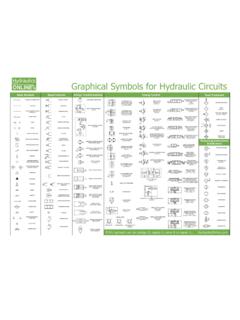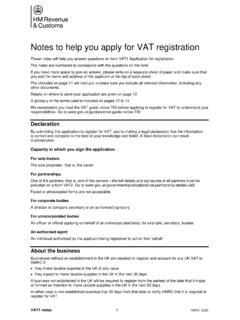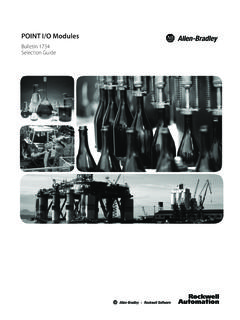Transcription of The Beginner’s Guide to Hydraulics: What Are Hydraulics ...
1 The Beginner s Guide to Hydraulics :What Are Hydraulics ?And How Do they Work?An introduction to the science of Hydraulics and hydraulic systemswhich explores the diversity of applications in which hydraulic systems can be found and how those systems Online e-book series:Sharing our knowledge of all things hydraulic About Hydraulics OnlineHydraulics Online is a leading, award-winning, ISO 9001 accredited provider of customer-centric fluid power solutions to 130 countries and 24 sectors committed employees and happy customers are the bedrock of our success is built on quality and technical know-how and the fact that we are 100% independent we provide truly unbiased advice and the most optimal solutions for our customers. Every TRUST QUALITY HERITAGEH ydraulics Online e-book: Hydraulics 3 Hydraulics is an engineering discipline which applies the theoretical science of fluid mechanics in order to generate, control and transmit power through the use of pressurised liquids.
2 Hydraulics PLURAL NOUN1. usually treated as singular the branch of science and technology concerned with the conveyance of liquids through pipes and channels, especially as a source of mechanical force or Hydraulic systems or forces. the lift is driven by Hydraulics Pronunciation: Hydraulics /h dr l ks//h dr l ks/As such, Hydraulics can refer to a branch of science as well as a type of mechanical system. Hydraulics can be found in so many different aspects of our lives. At the most basic, Hydraulics power the jet of water sprayed by a child s water pistol or the suction of a sink plunger. Advanced Hydraulics can be found in heavy earth-moving equipment, cranes and lifting platforms, industrial machinery and many vehicles. They are even hard at work in the human body! What is Hydraulics ? Hydraulics Online e-book series:Sharing our knowledge of all things hydraulicHydraulics Online e-book: Hydraulics 4 The term Hydraulics originates from the Greek (hydraulikos) a word composed of the Greek for water (hydor) and the Greek for pipe (aulos).
3 The ancient Greeks constructed sophisticated hydraulic systems, using water as their fluid. One early example is the Eupalinian aqueduct on the Greek island of Samos. This 1,036-metre-long tunnel was built in the 6th century BC to serve the ancient capital of Samos (now Pythagoreion) with fresh water. The tunnel was rediscovered in the 1880s and is now a popular tourist were the Greeks the only ancient civilization to use hydraulic systems. Ancient Rome was served by ancient hydraulic aqueducts, many of which still stand today across the former Roman Empire. Indeed, many ancient civilisations harnessed Hydraulics to power irrigation systems, freshwater supplies and other tools. Evidence of the an understanding of the science of Hydraulics exists in structures excavated from the Mesopotamian, Ancient Egyptian, Incan, Early Chinese and Sri Lankan ancient scienceHydraulics Online e-book: Hydraulics 5 One example of a hydraulic system with which everyone is familiar is our circulatory hearts use Hydraulics to pump our blood around our bodies and valves to govern the flow.
4 Hydraulics in the human bodyHydraulics Online e-book: Hydraulics 6 The components of a hydraulic systemSince Hydraulics is concerned with fluid mechanics, the most obvious component of any hydraulic system is the fluid. In our example of the human circulatory system, the hydraulic fluid is our an industrial system, the hydraulic fluid would typically be a standard mineral oil, a phosphate ester, or perhaps water glycol or skydrol, depending on the other main components that make up a hydraulic system are often referred to as a hydraulic power pack or power unit . The power unit comprises of: a prime mover the hydraulic pump a reservoir of fluid pipework and hoses actuators and valvesIn combination, these form the basics of a hydraulic our heart, it is the strong, regular contractions of the beating of our heart, stimulated by the heart s natural pacemaker the sinoatrial node, that applies pressure to our body s hydraulic system.
5 The sinoatrial node is our circulatory system s prime an industrial hydraulic system, the prime mover would typically be an electric motor or a diesel engine. This is what gets the hydraulic system started by powering the our heart, the left and right atria act as our hydraulic pump; contracting in unison to pump blood around our bodies. In an industrial system, the hydraulic pump converts mechanical energy into hydraulic energy by moving, or transmitting, the hydraulic fluid. There are several different types of hydraulic pumps in industrial use. These include gear, vane and piston pumps. In all cases, the role of the hydraulic pump is to displace fluid volume against a resistant load or pressure. The process which governs the working of this and any hydraulic system was named after French mathematician, Blaise Pascal, who proved that when pressure is applied to a fluid, that pressure will be evenly dispersed across the fluid.
6 As this pressure is applied, the hydraulic fluid moves around the system. In our circulatory system, it is our veins and arteries that operate as hydraulic fluid lines, transporting the hydraulic fluid our blood around the valves are used to start, stop and direct the flow of hydraulic fluid in the Online e-book: Hydraulics 7 Hydraulic actuators come at the end of the process, where the hydraulic energy is converted back to mechanical energy. This can be done through using a hydraulic cylinder which converts hydraulic energy into linear motion and work, or a hydraulic motor which converts hydraulic energy into rotary motion and important element of an industrial hydraulic system is the reservoir. The reservoir holds a volume of hydraulic fluid. The reservoir plays several important roles. First, it allows any solid contaminants to settle at the bottom of it, ensuing the purity of the system and reducing contamination that could cause failure.
7 It also transfers heat from the system which might prematurely damage seals or components and also serves to help air and moisture to be released from the Online e-book: Hydraulics 8 Hydraulics Online e-book: Hydraulics 9 Hydraulic principlesParticles in liquids are close together, meaning that liquids are virtually incompressible, cannot be compacted or squashed together. When moving around, the particles collide with one another and the walls of the container in which the liquid is housed. pressure MASS NOUN1. Continuous physical force exerted on or against an object by something in contact with MASS NOUN1. Strength or energy as an attribute of physical action or Physics An influence tending to change the motion of a body or produce motion or stress in a stationary body. The magnitude of such an influence is often calculated by multiplying the mass of the body and its of this property, a pressure applied to a liquid will spread to other points within the liquid.
8 Most notably, the pressure is transmitted equally in all directions. Even if the pressure is applied on a liquid at a single point, it will spread evenly to other points in the liquid. Hydraulic engineering is based on, and exploits, this principle, which is known as Pascal s Law after the French mathematician and writer who first set down the principle, Blaise Online e-book: Hydraulics we know that pressure and forces are spread through liquids with the pressure transmitted equally in all directions, it is important to understand that pressure and force are not quite the same thing. Pressure is directly proportional to force. However, pressure also takes into account the area over which the force is is calculated using the equation:Pressure (P) = Force (F) Cross-Sectional Area (A)Where: P = Pressure in pascals (Pa), F = Force in newtons (N), and A = Cross-sectional area in metres squared, m2 This means that when exerting a small force over a small cross-sectional area, pressure can be transmitted to create a large force over a large cross-sectional this way, hydraulic systems enable smaller forces to be multiplied into bigger forces.
9 This is what makes hydraulic systems so s LawHydraulics Online e-book: Hydraulics the application of hydraulicsA simple science experiment can be undertaken to illustrate how these hydraulic principles work in shows how forces can be multiplied using hydraulic will need: two syringes of different sizes plastic tubling waterYour two syringes of different sizes, Syringe A and Syringe B, should be connected together using the tubing and filled with water, as shown below. An effort force pushing on Syringe A increases the pressure on the water in Syringe A and the tube that follows it. As water is virtually incompressible, the pressure spreads through the water into Syringe B. The water pushes against the plunger in Syringe B with equal pressure, exerting a load force on , Syringe B has a plunger with a bigger cross-sectional area than Syringe A. This means that the load force exerted is larger than the original effort force (that which was exerted on Syringe A).
10 This is known as a force multiplier . Note, however, that although the pressure is greater, the bigger syringe moves a shorter distance than the smaller forceload forcesyringe Asyringe Bload force = effort force x area A area BHydraulics Online e-book: Hydraulics forces can be multipliedThe way forces can be multiplied in a hydraulic system was applied by Victorian industrialist Joseph Bramah to create the hydraulic press in was a prolific inventor, but is patent for the hydraulic press was his most important patent . In it he descibes a hydraulic press with two cylinders and pistons of differing cross-sectional areas which is used for obtaining and applying motive power .The basis of this invention was Pascal s Law; that the pressure through a closed system is constant. If a force was exerted on the smaller piston, this would translate to a larger force on the larger piston and the different would be proportional to the difference in cross-sectional area.








